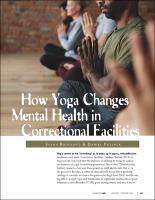Please use this identifier to cite or link to this item:
https://hdl.handle.net/20.500.12202/8647Full metadata record
| DC Field | Value | Language |
|---|---|---|
| dc.contributor.author | Radcliffe, Susan | - |
| dc.contributor.author | Pollack, Daniel | - |
| dc.date.accessioned | 2022-12-21T17:27:00Z | - |
| dc.date.available | 2022-12-21T17:27:00Z | - |
| dc.date.issued | 2023-01 | - |
| dc.identifier.citation | Radcliffe, S. and Pollack, D. (2023, Jan.-Feb.) How yoga changes mental health in correctional facilities. American Jail, 65-67. | en_US |
| dc.identifier.uri | https://hdl.handle.net/20.500.12202/8647 | - |
| dc.description | Journal article | en_US |
| dc.description.abstract | The takeaway is simple. If you want a physical exercise that helps restore the damage from job stress that you can do in your home with a video, and you can heal the limbic system of your brain, yoga might be for you. If you want a class that can help those who are incarcerated feel calm and heal the damage to their brains from trauma, yoga might be just the ticket. All aboard! | en_US |
| dc.language.iso | en_US | en_US |
| dc.publisher | American Jail Association, Hagerstown, Md., 2003- | en_US |
| dc.relation.ispartofseries | American Jail;Jan.-Feb. 2023 | - |
| dc.rights | Attribution-NonCommercial-NoDerivs 3.0 United States | * |
| dc.rights.uri | http://creativecommons.org/licenses/by-nc-nd/3.0/us/ | * |
| dc.subject | yoga | en_US |
| dc.subject | PTSD | en_US |
| dc.subject | trauma | en_US |
| dc.subject | incarcerated | en_US |
| dc.subject | jail | en_US |
| dc.title | How yoga changes mental health in correctional facilities | en_US |
| dc.type | Article | en_US |
| dc.contributor.orcid | 0000-0001-7323-6928 | en_US |
| local.yu.facultypage | https://www.yu.edu/faculty/pages/pollack-daniel | en_US |
| Appears in Collections: | Wurzweiler School of Social Work: Faculty publications | |
Files in This Item:
| File | Description | Size | Format | |
|---|---|---|---|---|
| Radcliffe Pollack art American Jails How Yoga Changes.pdf | 214.49 kB | Adobe PDF |  View/Open |
This item is licensed under a Creative Commons License

